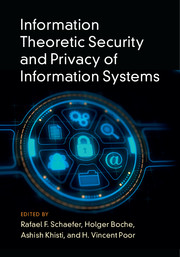Book contents
- Frontmatter
- Contents
- List of Contributors
- Preface
- Part I Theoretical Foundations
- Part II Secure Communication
- Part III Secret Key Generation and Authentication
- Part IV Data Systems and Related Applications
- 15 Information Theoretic Analysis of the Performance of Biometric Authentication Systems
- 16 Joint Privacy and Security of Multiple Biometric Systems
- 17 Information Theoretic Approaches to Privacy-Preserving Information Access and Dissemination
- 18 Privacy in the Smart Grid: Information, Control, and Games
- 19 Security in Distributed Storage Systems
- Index
- References
19 - Security in Distributed Storage Systems
from Part IV - Data Systems and Related Applications
Published online by Cambridge University Press: 28 June 2017
- Frontmatter
- Contents
- List of Contributors
- Preface
- Part I Theoretical Foundations
- Part II Secure Communication
- Part III Secret Key Generation and Authentication
- Part IV Data Systems and Related Applications
- 15 Information Theoretic Analysis of the Performance of Biometric Authentication Systems
- 16 Joint Privacy and Security of Multiple Biometric Systems
- 17 Information Theoretic Approaches to Privacy-Preserving Information Access and Dissemination
- 18 Privacy in the Smart Grid: Information, Control, and Games
- 19 Security in Distributed Storage Systems
- Index
- References
Summary
The proliferation of cloud applications in recent years has made securing the underlying distributed storage systems (DSSs) an important problem. This chapter focuses on the fundamental limits of information theoretic security in DSSs, with an emphasis on constructing efficient codes for achieving these limits. The challenge of studying security in DSSs results from their dynamic behavior characterized by nodes frequently leaving and joining the DSS. This dynamic behavior distinguishes them from static models typically studied in the area of information theoretic security. This chapter introduces the theoretical model of DSSs and summarizes the main results in the area. Three types of adversaries are studied: passive, active omniscient, and active limited-knowledge adversaries. For each type of attack, upper bounds on the secrecy or resiliency capacity are given, as well as capacity-achieving secure codes for certain regimes. Moreover, open problems are highlighted and discussed.
Introduction
Distributed storage systems have witnessed a rapid growth in recent years, driven by the advent of cloud applications. DSSs are used in data centers [1–6] and peer-to-peer (p2p) networks [7–10] to store large amounts of data and make it available online anywhere and anytime. The sheer volume of this data makes DSSs an obvious and lucrative target for malicious attacks, which can range from stealing private information (credit cards, fingerprints, etc.) to corrupting sensitive data [11–17]. This chapter focuses on the fundamental limits of information theoretic security [18–20] in DSSs, with an emphasis on constructing efficient codes for achieving these limits.
DSSs are typically formed of inexpensive and unreliable storage nodes that fail frequently, due to hardware failures [21], software failures and updates [22], and peer churning in p2p DSSs [7,9], causing temporary or even permanent data loss. Failures in DSSs are described by practitioners as being “the norm rather than the exception” [1]. To guarantee data reliability, the data is stored redundantly in DSSs. Moreover, when a node fails, or leaves the DSS, it is replaced by another node called a newcomer or replacement node, in what is referred to as the repair process [23]. This dynamic behavior of DSSs, in which nodes are frequently leaving and joining the system, distinguishes them from other communication systems in the literature on information theoretic security [24–27], which are static in general.
- Type
- Chapter
- Information
- Publisher: Cambridge University PressPrint publication year: 2017
References
- 2
- Cited by

